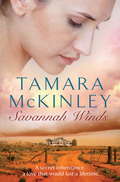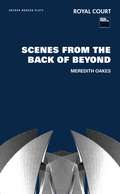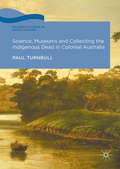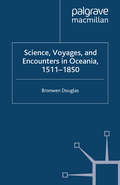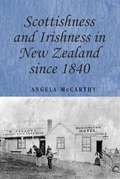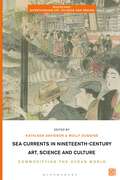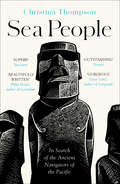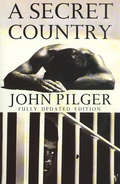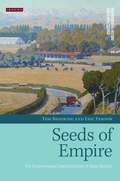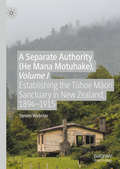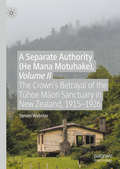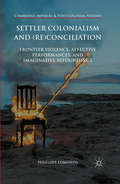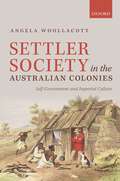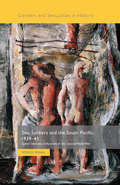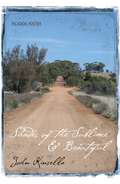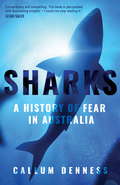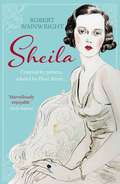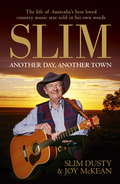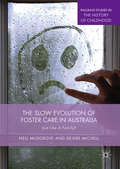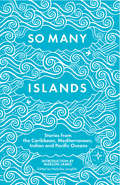- Table View
- List View
Savannah Winds
by Tamara McKinleyWhen Fleur receives word of a surprise inheritance from an aunt she never knew, it couldn't come at a more opportune moment. Her relationship is crumbling, and she's caught in the middle of a serious family rift. Consulting her aunt's long-lost diary, Fleur sets out on a voyage of historical discovery up the coast and through the Gulf Country, to the isolated cattle ranch Savannah Winds. But unbeknownst to Fleur, what she uncovers there could have devastating repercussions for her own life. Set between the 1930s and the modern day, Savannah Winds is an exploration of family ties, bitter rivalry and the strength of enduring love.
Scenes from the Back of Beyond (Oberon Modern Plays)
by Meredith OakesBill is sustained by his deep sense of a wider culture and an improving world. The only thing the human race needs to do is learn. When he meets a person who embodies this idea, he naturally likes them. Especially if his wife doesn't. Set at the end of the 1950s, Scenes from the Back of Beyond explores the comfort, hopes and fragility of family life in a new Sydney suburb. A production opened at the Royal Court Theatre, London in November 2006.
Science, Museums and Collecting the Indigenous Dead in Colonial Australia
by Paul TurnbullThis book draws on over twenty years’ investigation of scientific archives in Europe, Australia, and other former British settler colonies. It explains how and why skulls and other bodily structures of Indigenous Australians became the focus of scientific curiosity about the nature and origins of human diversity from the early years of colonisation in the late eighteenth century to Australia achieving nationhood at the turn of the twentieth century. The last thirty years have seen the world's indigenous peoples seek the return of their ancestors' bodily remains from museums and medical schools throughout the western world. Turnbull reveals how the remains of the continent's first inhabitants were collected during the long nineteenth century by the plundering of their traditional burial places. He also explores the question of whether museums also acquired the bones of men and women who were killed in Australian frontier regions by military, armed police and settlers.
Science, Museums and Collecting the Indigenous Dead in Colonial Australia
by Paul TurnbullThis book draws on over twenty years’ investigation of scientific archives in Europe, Australia, and other former British settler colonies. It explains how and why skulls and other bodily structures of Indigenous Australians became the focus of scientific curiosity about the nature and origins of human diversity from the early years of colonisation in the late eighteenth century to Australia achieving nationhood at the turn of the twentieth century. The last thirty years have seen the world's indigenous peoples seek the return of their ancestors' bodily remains from museums and medical schools throughout the western world. Turnbull reveals how the remains of the continent's first inhabitants were collected during the long nineteenth century by the plundering of their traditional burial places. He also explores the question of whether museums also acquired the bones of men and women who were killed in Australian frontier regions by military, armed police and settlers.
Science, Voyages, and Encounters in Oceania, 1511-1850 (Palgrave Studies in Pacific History)
by Bronwen DouglasBlending global scope with local depth, this book throws new light on important themes. Spanning four centuries and vast space, it combines the history of ideas with particular histories of encounters between European voyagers and Indigenous people in Oceania (Island Southeast Asia, New Guinea, Australia, New Zealand, and the Pacific Islands).
Scottishness and Irishness in New Zealand since 1840 (Studies in Imperialism)
by Angela McCarthyThis book examines the distinctive aspects that insiders and outsiders perceived as characteristic of Irish and Scottish ethnic identities in New Zealand. When, how, and why did Irish and Scots identify themselves and others in ethnic terms? What characteristics did the Irish and the Scots attribute to themselves and what traits did others assign to them? Did these traits change over time and if so how? Contemporary interest surrounding issues of ethnic identities is vibrant. In countries such as New Zealand, descendants of European settlers are seeking their ethnic origins, spurred on in part by factors such as an ongoing interest in indigenous genealogies, the burgeoning appeal of family history societies, and the booming financial benefits of marketing ethnicities abroad. This fascinating book will appeal to scholars and students of the history of empire and the construction of identity in settler communities, as well as those interested in the history of New Zealand.
Sea Currents in Nineteenth-Century Art, Science and Culture: Commodifying the Ocean World (Biotechne: Interthinking Art, Science and Design)
by Kathleen Davidson and Molly DugginsHow did scientists, artists, designers, manufacturers and amateur enthusiasts experience and value the sea and its products? Examining the commoditization of the ocean world during the nineteenth century, this book demonstrates how the transaction of oceanic objects inspired a multifaceted material discourse stemming from scientific exploration, colonial expansion, industrialization, and the rise of middle-class leisure. From the seashore to the seabed, marine organisms and environments, made tangible through processing and representational technologies, captivated practitioners and audiences. Combining essays and case studies by scholars, curators, and scientists, Sea Currents investigates the collecting and display, illustration and ornamentation, and trade and consumption of marine flora and fauna, analysing their material, aesthetic and commercial dimensions. Traversing global art history, the history of science, empire studies, anthropology, ecocriticism and material culture, this book surveys the currency of marine matter embedded in the economies and ecologies of a modernizing ocean world.
Sea Currents in Nineteenth-Century Art, Science and Culture: Commodifying the Ocean World (Biotechne: Interthinking Art, Science and Design)
How did scientists, artists, designers, manufacturers and amateur enthusiasts experience and value the sea and its products? Examining the commoditization of the ocean world during the nineteenth century, this book demonstrates how the transaction of oceanic objects inspired a multifaceted material discourse stemming from scientific exploration, colonial expansion, industrialization, and the rise of middle-class leisure. From the seashore to the seabed, marine organisms and environments, made tangible through processing and representational technologies, captivated practitioners and audiences. Combining essays and case studies by scholars, curators, and scientists, Sea Currents investigates the collecting and display, illustration and ornamentation, and trade and consumption of marine flora and fauna, analysing their material, aesthetic and commercial dimensions. Traversing global art history, the history of science, empire studies, anthropology, ecocriticism and material culture, this book surveys the currency of marine matter embedded in the economies and ecologies of a modernizing ocean world.
Sea People: In Search Of The Ancient Navigators Of The Pacific
by Christina Thompson‘Wonderfully researched and beautifully written’ Philip Hoare, author of Leviathan ‘Succeeds in conjuring a lost world’ Dava Sobel, author of Longitude ‘Fascinating and satisfying’ Simon Winchester, author of The Map that Changed the World
A Secret Country
by John PilgerExpatriate journalist and film-maker John Pilger writes about his homeland with life-long affection and a passionately critical eye. In this fully updated edition of A Secret Country, he pays tribute to a little known Australia and tells a story of high political drama.
Seeds of Empire: The Environmental Transformation of New Zealand (Environmental History and Global Change)
by Tom Brooking Eric PawsonThe traditional image of New Zealand is one of verdant landscapes with sheep grazing on lush green pastures. Indeed, as far back as the nineteenth century, promotional literature declared its soils to be rich, its weather invariably benign; whilst artists' paintings bathed it in an almost subtropical glow. Such representations, however, were at best partial, at worst unrealistic, for this landscape is almost entirely an artificial creation.The transformation of the New Zealand landscape took place as Britain became increasingly reliant on its overseas territories for supplies of food and raw material. All over the Empire indigenous plants were replaced with 'English grasses', to provide the worked up products of pasture - meat, butter, cheese, wool and hides. These 'seeds of empire' were in the vanguard of colonial development and in New Zealand this process was carried to an extreme as swamps were drained and hundreds of thousands of hectares of rain forest were burnt and re-seeded with imported grasses. Seeds of Empire provides an innovative and challenging look at the impact of this European settlement and development of New Zealand's landscape and environment. In exploring how, why and with what consequences New Zealand was transformed into these 'empires of grass' the authors provide not just an exciting reappraisal of New Zealand's environmental history but a long overdue exploration of the significance of grass in the processes of sowing empire.
A Separate Authority (He Mana Motuhake), Volume I: Establishing the Tūhoe Māori Sanctuary in New Zealand, 1894–1915
by Steven WebsterThis book is an ethnohistorical reconstruction of the establishment in New Zealand of a rare case of Maori home-rule over their traditional domain, backed by a special statute and investigated by a Crown commission the majority of whom were Tūhoe leaders. However, by 1913 Tūhoe home-rule over this vast domain was being subverted by the Crown, which by 1926 had obtained three-quarters of their reserve. By the 1950s this vast area had become the rugged Urewera National Park, isolating over 200 small blocks retained by stubborn Tūhoe "non-sellers". After a century of resistance, in 2014 the Tūhoe finally regained statutory control over their ancestral domain and a detailed apology from the Crown.
A Separate Authority (He Mana Motuhake), Volume II: The Crown’s Betrayal of the Tūhoe Māori Sanctuary in New Zealand, 1915–1926
by Steven WebsterFollowing on from Volume I on the formation of the Urewera District Native Reserve, this monograph examines the period from 1908 to 1926, during which time the Crown subverted Tūhoe control of the UDNR, established a mere decade earlier. While Volume I described how the Tūhoe were able to deploy kin-based power to manipulate Crown power as well as confront one another, this volume describes ways in which the same ancestral descent groups closed ranks to survive nearly two decades of predatory Crown policies determined to dismantle their sanctuary. A relentless Crown campaign to purchase individual Tūhoe land shares ultimately resulted in a misleading Crown scheme to consolidate and relocate Tūhoe land shares, thereby freeing up land for the settlement of non- Tūhoe farmers. By the 1950s, over 200 small Tūhoe blocks were scattered throughout one of the largest National Parks in New Zealand. Although greatly weakened by these policies in terms of kinship solidarity as well as land and other resources, Tūhoe resistance continued until the return of the entire park in 2014—with unreserved apologies and promises of future support. In both volumes of A Separate Authority (He Mana Motuhake), Webster takes the stance of an ethnohistorian: he not only examines the various ways control over the Urewera District Native Reserve (UDNR) was negotiated, subverted or betrayed, and renegotiated during this time period, but also focuses on the role of Māori hapū, ancestral descent groups and their leaders, including the political economic influence of extensive marriage alliances between them. The ethnohistorical approach developed here may be useful to other studies of governance, indigenous resistance, and reform, whether in New Zealand or elsewhere.
Settler Colonialism and: Frontier Violence, Affective Performances, and Imaginative Refoundings (Cambridge Imperial and Post-Colonial Studies Series)
by Penelope EdmondsThis book examines the performative life reconciliation and its discontents in settler societies. It explores the refoundings of the settler state and reimaginings of its alternatives, as well as the way the past is mobilized and reworked in the name of social transformation within a new global paradigm of reconciliation and the 'age of apology'.
Settler Society in the Australian Colonies: Self-Government and Imperial Culture
by Angela WoollacottThe 1820s to the 1860s were a foundational period in Australian history, arguably at least as important as Federation. Industrialization was transforming Britain, but the southern colonies were pre-industrial, with economies driven by pastoralism, agriculture, mining, whaling and sealing, commerce, and the construction trades. Convict transportation provided the labour on which the first settlements depended before it was brought to a staggered end, first in New South Wales in 1840 and last in Western Australia in 1868. The numbers of free settlers rose dramatically, surging from the 1820s and again during the 1850s gold rushes. The convict system increasingly included assignment to private masters and mistresses, thus offering settlers the inducement of unpaid labourers as well as the availability of land on a scale that both defied and excited the British imagination. By the 1830s schemes for new kinds of colonies, based on Edward Gibbon Wakefield's systematic colonization, gained attention and support. The pivotal development of the 1840s-1850s, and the political events which form the backbone of this story were the Australian colonies' gradual attainment of representative and then responsible government. Through political struggle and negotiation, in which Australians looked to Canada for their model of political progress, settlers slowly became self-governing. But these political developments were linked to the frontier violence that shaped settlers' lives and became accepted as part of respectable manhood. With narratives of individual lives, Settler Society shows that women's exclusion from political citizenship was vigorously debated, and that settlers were well aware of their place in an empire based on racial hierarchies and threatened by revolts. Angela Woollacott particularly focuses on settlers' dependence in these decades on intertwined categories of unfree labour, including poorly-compensated Aborigines and indentured Indian and Chinese labourers, alongside convicts.
Sex, Soldiers and the South Pacific, 1939-45: Queer Identities in Australia in the Second World War (Genders and Sexualities in History)
by Yorick SmaalSex, Soldiers and the South Pacific, 1939-45 explores the queer dynamics of war across Australia and forward bases in the south seas. It examines relationships involving Allied servicemen, civilians and between the legal and medical fraternities that sought to regulate and contain expressions of homosex in and out of the forces.
Shades of the Sublime & Beautiful
by John KinsellaAustralian John Kinsella is one of the most highly regarded poets currently writing in English. Taking Edmund Burke’s 250-year old masterpiece A Philosophical Enquiry into the Origin of Our Ideas of the Sublime and Beautiful as his template, Kinsella has produced his most accomplished and broadly representative work to date. Shades of the Sublime & Beautiful is a warm, human, anecdotally rich book, concentrating many of the themes that have obsessed its author over the last twenty years: language, love, the invocation of place, the mysteries of the Australian wilderness, and our mediations between the human and natural realms. Together, these lyric meditations build towards a profound thesis on the ecology of the imagination, and are always conducted in concrete, vivid and exuberant language that is unmistakably Kinsella’s own. ‘Kinsella’s poems are a very rare feat: they are narratives of feeling. Vivid sight – of landscapes, of animals, of human forms in distant light – becomes insight. There is, often, the shock of the new. But somehow awaited, even familiar. Which is the homecoming of a true poet’ George Steiner ‘John Kinsella is an Orphic fountain, a prodigy of the imagination . . . he frequently makes me think of John Ashbery: improbable fecundity, eclecticism, and a stand that fuses populism and elitism in poetic audience’ Harold Bloom
Sharks: A History Of Fear In Australia
by Callum DennessFor as long as people have lived in Australia, the shark has loomed large in our fears. From the Noongar people of Western Australia who stayed out of the water for fear of being taken, to media hysteria about attacks and even sightings today, sharks occupy the dark recesses of our national psyche unlike any other predator. They challenge the very sense of ourselves as Australians, a people who hug the coastline and love the freedom of the surf. And the dispute between whether to kill or protect sharks cuts to the political core of our nation, yet another divide between the right and the left. There is no denying that shark attacks have been increasing in recent years, and so have our fears. Where do we go from here? How worried should we be? Journalist Callum Denness deep-dives into the history of our relationship with sharks, and circles our fear by talking to activists, marine biologists, politicians, surfers, survivors and those who’ve lost loved ones. Compelling and challenging, this is the clearest picture yet of whether or not we can co-exist with sharks. Don’t get back into the water until you read Sharks: A History of Fear in Australia.
Sheila: The Australian ingenue who bewitched British society
by Robert WainwrightVivacious, confident and striking, young Australian Sheila Chisholm met her first husband, Lord Loughborough, in Egypt during the First World War. Arriving in London as a young married woman, she quickly conquered English society, and would spend the next half a century inside the palaces, mansions and clubs of the elite. Her clandestine affair with young Bertie, the future George VI, caused ruptures at Buckingham Palace, with King George offering his son the title Duke of York in exchange for never hearing of Sheila again.She subsequently became Lady Milbanke, one of London's most admired fashion icons and society fundraisers and ended her days as Princess Dimitri of Russia, juggling her royal duties with a successful career as a travel agent. Throughout her remarkable life, Sheila won the hearts of men ranging from Rudolph Valentino and Vincent Astor to Prince Obolensky, and maintained longstanding friendships with Evelyn Waugh, Noël Coward, Idina Sackville and Nancy Mitford.A story unknown to most, Sheila is a spellbinding account of an utterly fascinating woman.
Slim: Another Day, Another Town (Slim Dusty Songbooks Ser.)
by Slim Dusty Joy McKeanAustralia's greatest country singer-songwriter Slim Dusty's own story, written with Joy McKean, his wife for 50 years - now updated.'It seems I've done most things I wanted to do, but of all things, I think I most enjoy finding good songs and recording them. There are so many songs I want to record that I will be kept busy for as long as I can keep it up ... It is the people you meet along the road of life who make the travelling easier. No wonder I loved it all.' - Slim DustySlim Dusty was Australia's most well-loved and best known country music performer. A legend in the bush, his famous hit 'A Pub With No Beer' made him a household name in the towns and cities too.This is the story of the life that Slim Dusty and Joy McKean shared for their fifty years of marriage and touring together - their love for each other, their family and their music - and their determination to bring country music to the whole of Australia. Slim died in 2003, but throughout Australia, and around the world, people are still playing his songs and passing them on to new generations of fans. In this updated edition of the classic autobiography, Joy McKean writes about her family's commitment to honouring his memory and their work to keep his name alive.If you love today's Australian country music, this is the story of where it all started.'... just like his lyrics, the prose is perfect. Here he is talking about the early Dusty days. It's just like listening to a bright spark in the bush.' - The Age'Slim blazed the red-dirt trail for Australian singer/songwriters, allowing us to remain unashamedly ourselves.' - Missy Higgins
The Slow Evolution of Foster Care in Australia: Just Like a Family? (Palgrave Studies in the History of Childhood)
by Nell Musgrove Deidre MichellThis book draws on archival, oral history and public policy sources to tell a history of foster care in Australia from the nineteenth century to the present day. It is, primarily, a social history which places the voices of people directly touched by foster care at the centre of the story, but also within the wider social and political debates which have shaped foster care across more than a century. The book confronts foster care’s difficult past—death and abuse of foster children, family separation, and a general public apathy towards these issues—but it also acknowledges the resilience of people who have survived a childhood in foster care, and the challenges faced by those who have worked hard to provide good foster homes and to make child welfare systems better. These are themes which the book examines from an Australian perspective, but which often resonate with foster care globally.
The Slow Evolution of Foster Care in Australia: Just Like a Family? (Palgrave Studies in the History of Childhood)
by Nell Musgrove Deidre MichellThis book draws on archival, oral history and public policy sources to tell a history of foster care in Australia from the nineteenth century to the present day. It is, primarily, a social history which places the voices of people directly touched by foster care at the centre of the story, but also within the wider social and political debates which have shaped foster care across more than a century. The book confronts foster care’s difficult past—death and abuse of foster children, family separation, and a general public apathy towards these issues—but it also acknowledges the resilience of people who have survived a childhood in foster care, and the challenges faced by those who have worked hard to provide good foster homes and to make child welfare systems better. These are themes which the book examines from an Australian perspective, but which often resonate with foster care globally.
So Many Islands: Stories from the Caribbean, Mediterranean, Indian and Pacific Oceans
by Nicholas Laughlin Nailah Folami ImojaSo Many Islands breaks out bold new writing from the distant shores of countries in the Caribbean, Mediterranean, Indian and Pacific oceans. Here you will find poems about revolution and protest. You will be transported to Marakei, ‘the women’s island’, and join the battle to save a beached whale. Alongside family politics, So Many Islands tackles nuclear testing and climate change – global issues that are close to the heart of these precariously poised communities. Giving voice to their challenges and triumphs, these writers create a vibrant portrait of what it is like to live and love on the small islands they call home. Readers everywhere will find universal connections with their words and worlds. Antigua and Barbuda, Barbados, Bermuda, Cyprus, Grenada, Jamaica, Kiribati, Malta, Mauritius, Niue, Rotuma (Fiji), Samoa, Singapore, Saint Lucia, Saint Vincent and the Grenadines, Tonga, Trinidad and Tobago
